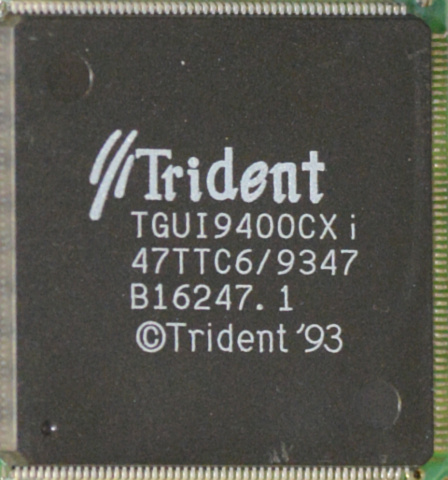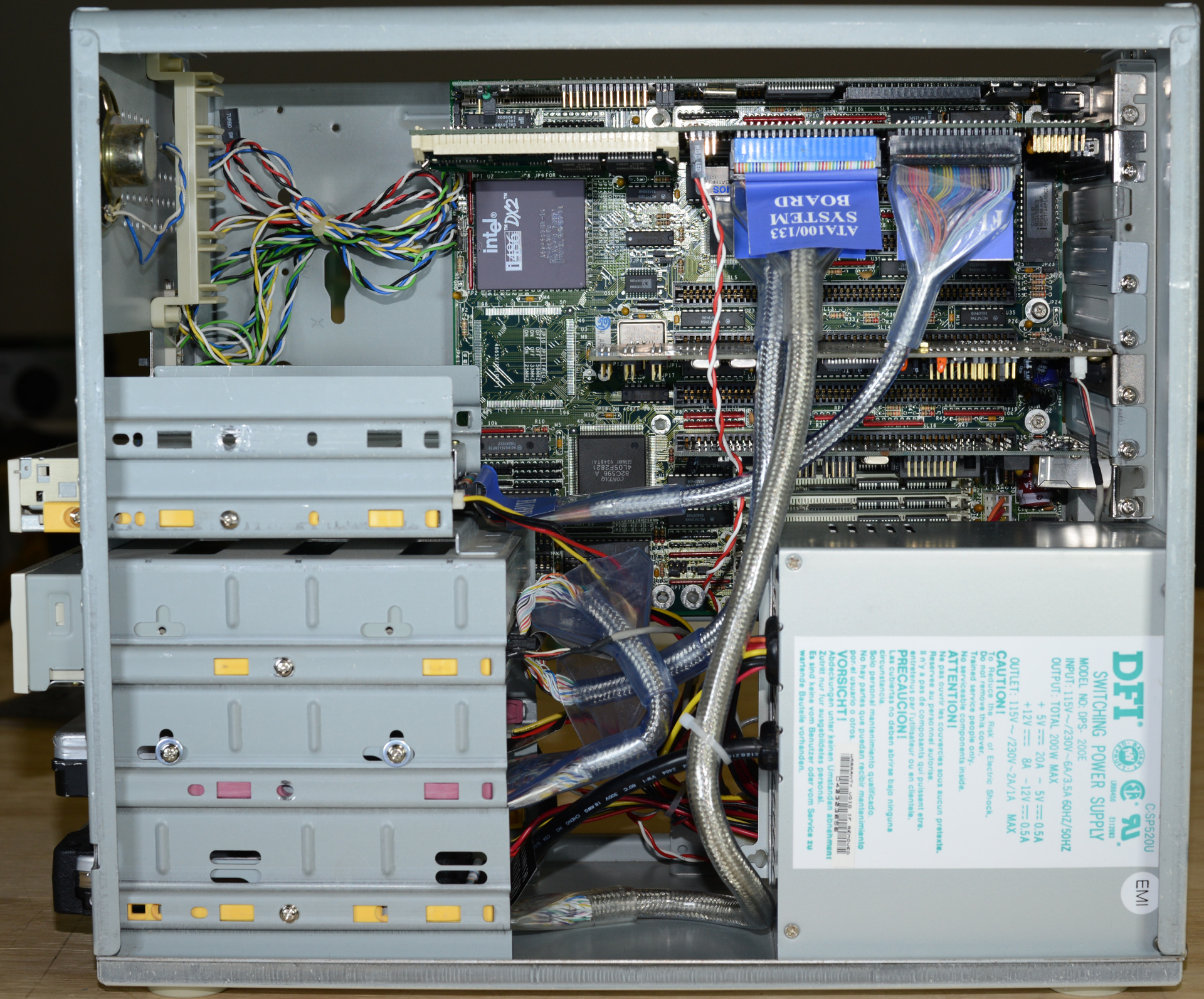DFI 486
Last modified: 2023-08-05 19:22
| Vintage | 1994-07 |
| Form factor | Baby AT |
| CPU | 66 MHz 486 DX2 (P24), sSpec SX807 |
| CPU socket | 486 socket |
| CPU maximum power dissipation | 6.3 W |
| Motherboard | DFI 486-CCV Rev. A |
| Chipset | Contaq 82C596 A |
| Last BIOS version | 1992-11-11 |
| RAM |
8 MiB (8 × 1 MiB 70 ns parity SIMM, 30-pin)
Upgraded to 32 MiB (8 × 4 MiB same) |
| L2 cache | 128 KiB |
Next up from the Freecycle pile was a 486 that appeared to be loaded with
add-in cards. The VGA card, sound card, and modem all stood a chance of
being useful, but what really caught my eye was the non-SoundBlaster game
port. Getting two joysticks to work on a SoundBlaster game port requires a
soldering iron due to some of the pins being commandeered for MIDI. This
game port might meet the original spec and work without modification to
allow Llamatron to be
played as intended.
Then I opened the case, and what I found was hurl-worthy.
Yuck. Ribbon cables must breed like hangers.
And what are these mondo long slots? Could it be... VESA Local
Bus? The horror. The shame. The obscurity.
VESA Local Bus (VLB) was a flash in the pan, a dead-end interface. I
leapfrogged the 486 generation of processors when they were current, so this
was my first encounter with it. This VGA card is useless in any other
system, as is the I/O controller card to which the IDE hard drive, floppy
drives, serial ports, parallel port, and game port are all connected.
In another bad omen, the CD-ROM was cabled to an IDE interface on a sound
card with the same branding (Aztech).
The sound card does not have a generic CD-ROM interface like some later
models have; instead, it has three separate IDE-ish headers labelled Sony,
Mitsumi, and Panasonic. The model CDA 268-01A CD-ROM was connected to the
Mitsumi header and presumably was manufactured by Mitsumi. I noticed that it
lacked the Master/Slave/Cable Select jumper that IDE CD-ROMs typically
have.
The CD-ROM showed up neither in the BIOS nor
in Smart BootManager.
As expected, connecting the CD-ROM to the main IDE channel did not work. But
neither did it work to connect a later model, generic ATAPI CD-ROM to the
main IDE channel. Bogus!
The DFI 486-CCV Rev. A motherboard has
an AMI BIOS. DFI (Diamond Flower, Inc.) still exists as a manufacturer of
motherboards both mainstream and special-purpose, but unfortunately, their
BIOS downloads did not include an update for this old computer. Abandon all
hope of booting from CD.
After testing a kernel with a boot floppy, I set aside the 210 MB hard
drive that came with the computer and installed a couple of larger hard
drives that I had pre-loaded with Slackware 12.1 in a linear RAID (JBOD)
configuration.
Getting Slackware to run with only 8 MiB of RAM was
challenging. The motherboard supports a maximum of 32 MiB.
The Trident TVGA 9400CXi VGA card is supposedly supported by the Trident
driver of X.Org, but it didn't detect the card. The generic VESA driver
worked and fired up a 1024×768×8bpp interlaced mode. VGA bandwidth as judged
by scrolling text in xterms was surprisingly good for an unaccelerated
driver.
I had some issues getting the modem to be detected. It turned out that
the DTC2278VL rev "B" multi I/O controller card
was mis-jumpered
such that the conflicting second serial port was only half-disabled. The
address was disabled but not the IRQ.
The microscopic print says it is a Best Data model 1442FQ, 1442VTQ or
1442FTQ. The commands ati0 and at+fclass=? revealed it to be a 14.4 kbit/s
Class 1 fax modem that was obviously Linux-compatible.
Such a modem has its uses.
Things went downhill after that. I could not get the sound card to
work [but did eventually—see 2013 addendum below].
The documentation for the snd-cs4231 kernel module states, "This module
does not support autoprobe thus main port must be specified!!!" My only clue
about what port to specify was the jumper label, Base Address 22XH. So I
specified port=0x220 and tried every reasonable guess for irq, dma1 and dma2,
but it never worked. I even tried changing the "CONFIG MODE" jumper from
"SOFTWARE SETTING" to "EEPROM SETTING" on the chance this would avoid the
need for some driver that I don't have, but to no avail.

Aztech had
an obscure
ftp site supporting their legacy products, but I wasn't able to find any
of that at the time, much less figure out how to get it working
from plain DOS. Thus I had no
configurator for the Aztech sound card nor even any documentation on what its
default setup might be. As it was, with no configuration, DOOM was
functional with settings of port 0x220, IRQ 5 and DMA 1. However, Llamatron
hung before long and Mpxplay hung immediately.
I went back and tried various Linux drivers with the configuration
validated under DOS and found that the snd-sb8 driver would work with those
settings for a few seconds, followed by a total system hang.
Addendum, 2013-03: What was actually needed was
the azt1605
module that had not yet appeared in the mainline
kernel. Now it works.
I had better luck replacing the Aztech sound card with
an ESS ES1868 ISA PnP AudioDrive card
salvaged from a PC someone left at the curb on trash day.
The ALSA driver
for this card was apparently broken,
but ESS at the time was good enough to
support their legacy products and to provide a DOS configurator for them.
After using their DOS setup utility to perform the PnP configuration and
setting the BLASTER variable appropriately, the AudioDrive card functioned
well enough for Mpxplay and all of my old DOS games to run.
With the sound working, it was finally possible to determine the limits of
the 486 CPU. Mpxplay was able to play an uncompressed WAV file at 44.1 kHz
if I turned off its CPU-hogging spectrum analyzer; however, it was not
possible to play an MP3 except by first decompressing it to WAV. Similarly,
the DOOM framerate could be described as merely acceptable.
As for the I/O card, I changed jumpers to increase the IDE data
transfer rate from its default of 3.9 MB/s (slightly above PIO 0) to its
maximum of 8.3 MB/s (equivalent to PIO 2) with no adverse effects, and Linux
boot time reduced by 12%. However, no matter what I tried, the 2.6 kernel
utterly failed to detect the game port. Sigh. With a 2.4 kernel
this might work.
Under DOS, with a joystick connected to the gameport, I was able to use the
fire button to start Llamatron, but it hung immediately afterward. The
hang occurred even when there was no sound card in the system to
conflict. If Llamatron was configured to use keyboard instead of joystick
it worked fine.
So much for that. I disabled the I/O card gameport and used the one
on the sound card.
Although getting Slackware to run in 8 MiB of RAM was a worthy challenge,
I did eventually get sick of waiting and paid $21.90 (shipping included) on
EBay for a matched set of 8 of the hard-to-get 4 MiB SIMMs to make it run
half decently. That's $700 per GiB!
These SIMMs, which were advertised as 3-chip, 4 MiB, 70 ns parity RAMs—a
safe choice to replace the 3-chip, 1 MiB, 70 ns parity RAMs that were in
there—have two chips that store 4 bits of each byte (LGS GM71C17400BJ6 =
16 Mib 60 ns) plus one different chip that I can't find any info on
(Mitsubishi M5M44100BTP or 451SJ00-7). It probably is a legitimate 4 Mib
RAM, but for SIMMs of this vintage, you have to watch out for "fake parity,"
where a logic chip is used in lieu of the extra RAM to fake out the PC.
So, finally... Gone are the original hard drive, 5¼″ floppy drive,
nonstandard Aztech CD-ROM + sound card combo, modem, disabled gameport, DB-25
serial port, pin 20 from the IDE interface, 8 MiB RAM, and loads of ribbon.
Added are two 3.2 GB hard drives, the ESS sound card (minus pin 20
from its IDE interface), an ATAPI CD-ROM drive, 32 MiB RAM, and three
round cables. (A black A.C.Ryan IDE cable connecting the sound card to the
CD-ROM is hiding in the back.)
After rerouting that long power-switch cable and tying down the other
power cables it almost ceased to be hideous. Almost. There's only so much
you can do with this layout.
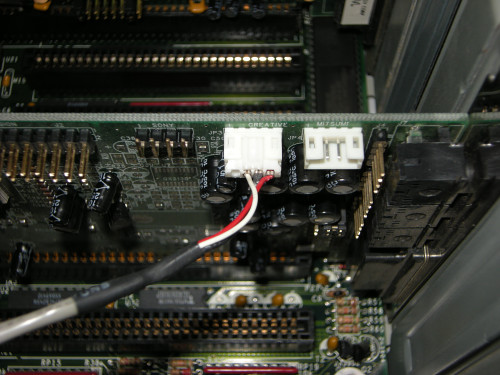
The ATAPI CD-ROM drive is specifically a Sony CDU701–F. It worked under
Linux with the old PnP EIDE support module, but the generic DOS drivers
didn't work and Sony no longer provides DOS drivers on their web site
(SIGH!). I scrounged version 2.27b of their driver distribution from the
net, and it works, but only if Linux is booted before DOS. Apparently
the ESS PnP configurator configures the sound and gameport but not the IDE
interface; if the PnP settings are configured by Linux, they stick through a
warm boot.
The Sony driver distribution includes a program, CDPLAY.EXE, that allows
the PC to function as a CD player if the (otherwise useless) analog wire from
the CD-ROM to the sound card is hooked up. (I used the Creative header
instead of the Sony one, so sue me.)
Addendum, 2013-10: What was needed was ES1868.COM, the "ESS IDE CD-ROM
controller enable program," which
is buried in the Windows driver
distribution. Once
enabled, generic DOS CD/DVD-ROM
drivers work and are preferable to the Sony proprietary drivers.
504 MiB limit
That crufty old LILO warning about 1024 cylinders actually bit me this
time. The ancient BIOS does not support LBA at all. LILO, DOS, and anything
else that goes through the BIOS can only access the first 504 MiB (1024
cylinders × 16 heads × 63 sectors) of a disk. And yes, for once the geometry
matters. I went many rounds with fdisk to get the partition table right.
Installing Disk Manager 9.56a fixes the problem for DOS, but unfortunately
the maintainers of the 2.6 Linux kernel have seen fit to break
interoperability with Disk Manager. I would have to either revert to an old
kernel or settle for the DOS partitions being inaccessible from within
Linux.
As a compromise, I partitioned both disks so that the first 1024 cylinders
belong to DOS, with the exception of a small Linux boot partition, and all
cylinders above 1024 belong to Linux. I also switched to smaller hard drives
to save the (marginally) better parts for projects where I could use
them.
Bad module
Making the CD-ROM work with the 2.6.27.4 kernel meant abandoning the
non-functional "ISA Plug and Play PATA support (Experimental)" module of
libata and reverting to the "PNP EIDE support" under the old
"ATA/ATAPI/MFM/RLL support" driver. Experimental or not, using libata
exclusively for all SATA and PATA drives had always been a big win
prior to this; this was the first time I had to go back to the old driver for
any reason.
Non-repeating failures
For a while there the CMOS clock was not keeping time while the PC was
off. With daily use the problem has stopped repeating. I imagine
that this slightly corroded fossil of a battery is responsible for the problem,
which will surely come back if the PC is left off for a longer period of
time. Call me senile, but I do seem to recall that normal watch batteries
had been invented by 1994....
At one point I got this "interesting" error message under Linux:
Uhhuh. NMI received for unknown reason a0 on CPU 0.
You have some hardware problem, likely on the PCI bus.
Dazed and confused, but trying to continue
Uhhuh. "I see no PCI bus here." The error coincided with the floppy
drive going flaky. Removed and reattached the floppy cable, rebooted, and
the problem did not repeat.
Conclusion
This project was complicated but the payoff was good. The 486 now runs
all of my old DOS games with fewer glitches than I have experienced on any
other PC, including the 386 DX that I owned back in the day. The sound does
not cut out. The screen does not flicker. It does not hang. The only
glitch I have had is CC3D dying with an error message about not finding the
file 3.res, and that might be an installation snafu.
2013-10-06: The punishment for fixing what ain't broke is never waived
So, a few years later, I decided it was time to upgrade Linux to Slackware
14.0, replace DOS with my new standard configuration, replace the CD-ROM with
a DVD-ROM, add an NE2000 network card, and see if I could get it to work with
a single, larger hard drive.
Everything was going better than expected right up to the point where I
attached the newly loaded hard drive and tried to boot. From then on,
no matter what I tried, the BIOS would say DRIVE NOT READY ERROR and fail to
boot the hard drive. Any attempts to mess with the MBR or partition
table from a DOS boot floppy led to data corruption and failure. Even
the untouched boot drive that previously was working would no longer
boot.
Having eliminated all possible software and BIOS configuration causes, I
expensively ordered a replacement VLB I/O card. Ironically, now that I
had gotten the ESS sound card's IDE header totally figured out, the new I/O
card had native CD-ROM support and even made it possible to boot from the
DVD-ROM drive with the aid of Smart BootManager.
2013-10-12: The new card arrived. Out with the crappy, old
Winbond W83758P-based card...

And in with the new and improved, fancy-shmancy card with a
PDC20230C-based controller and a W83758P on the side. The so-called LBA
support in Promise's BIOS is limited to 8.4 GB, but that's a heckuva lot
better than 504 MiB.

Alas, that upgrade was the beginning of a fresh hell caused by the new
card's quirky incompatibilities with Linux.
Toward the beginning of the troubleshooting process I was switching the
hard drive back and forth between two PCs to avoid the pain of running a
Slackware install on the 486. On one of those trips, the metal grommets
in both of the plastic rails spun and the drive assembly was then
royally stuck in the 486. The extreme measures that were needed
to free it killed messed up the hard drive for a while and did nothing
good for the rest of the PC.
Four months later, after some really
painful kernel debugging that accomplished little, I finally got Linux
running again on the 486 by relegating it to the secondary channel with that
crappy good ol' Winbond W83758P controller that Promise only intended
to drive CD-ROMs.
During the Linux blackout I learned that the DOS games that run best on
the 486 use
only Adlib sound,
so I went back to the original Aztech sound card. Unusually, it
physically collided with mainboard components in both of the bottom two
slots.
I ran the final Slackware 14.1 install on the 486 itself, but due to
limited memory the initrd of the installation environment had to be converted
from a ramdisk to a copy-on-write root file
system. Package installation took 24 hours to run. Booting to
a bash prompt then further required editing rc.M to remove the ampersands
from a series of bloaty cache-updating operations that Slackware now fires
off into the background. There's just not enough memory to run them all
at the same time.
Getting Linux back and upgraded was a wimpy victory. The issues with
the new HDD controller left Linux unable to write safely to the DOS
partition, and even with the correct ALSA module it still was difficult to
play a WAV file without bursts of static or a hard lockup. (The same
sound card and driver worked fine in a Pentium-class PC.) And then
there's this: X.Org no
longer works at all.
The one shining victory was that I finally got the 486 on the
network with an ISA NE2000 type card. (Oooh, it says "Netware.")
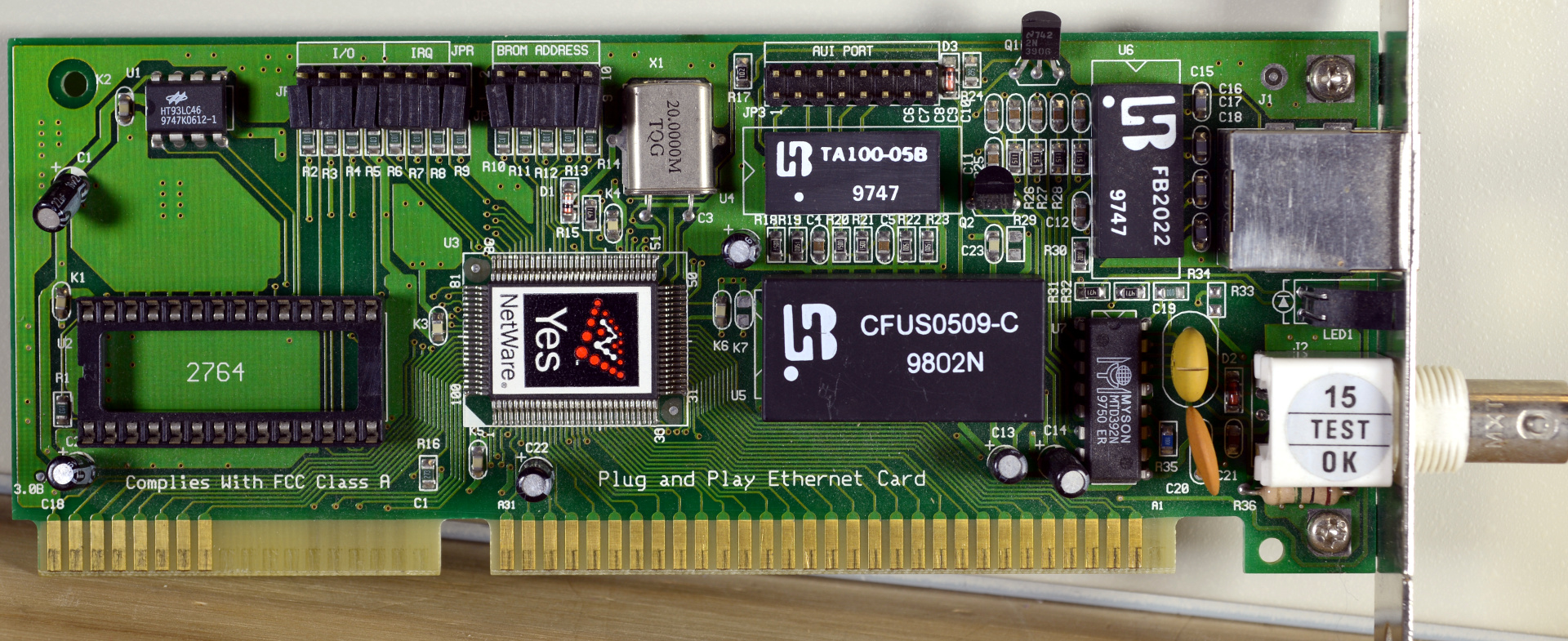
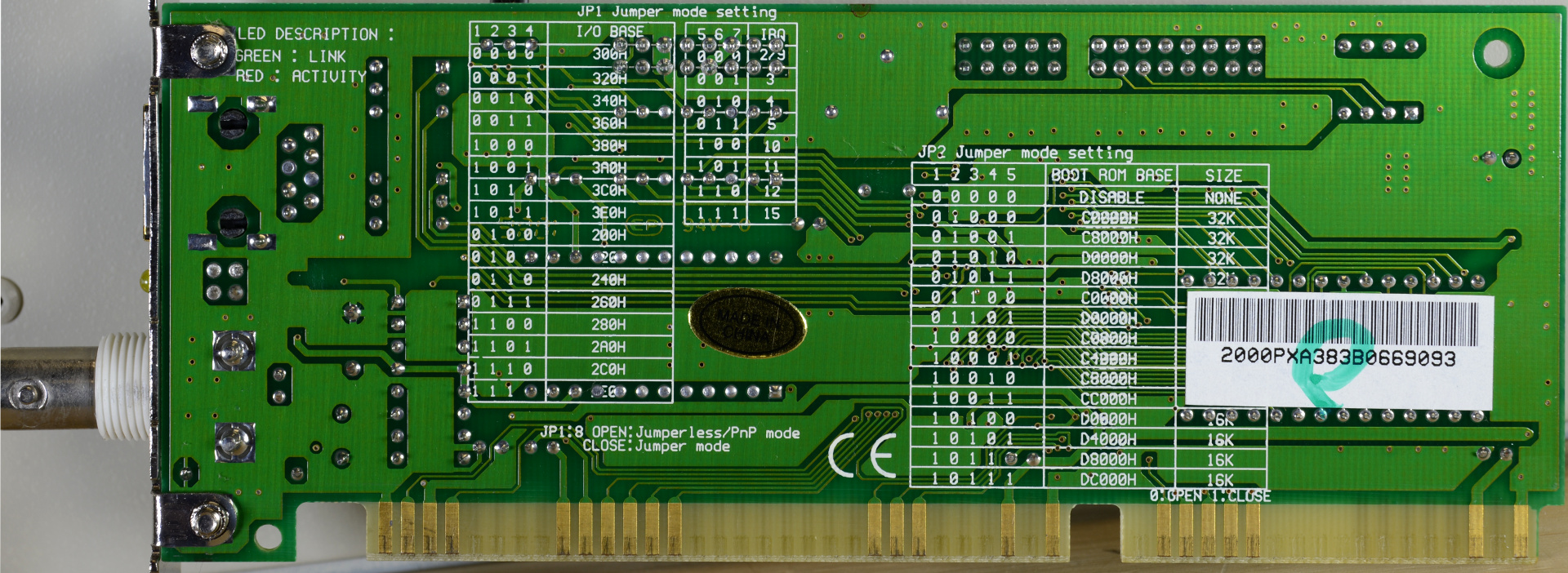
I got no-boot or hard lockups on every previous attempt to put a network
card in the 486. I speculated that the ROMs were conflicting with the
Promise controller, so this time I chose a card that could be jumpered to
disable its ROM. But this time there were no hard lockups. Instead, the
network card initialized and then failed mysteriously on the first attempt to
transmit. It turned out that the sneaky Aztech sound card was stealthily
hooking IRQ 5 after the NE2000 had grabbed it, even though the ALSA module
had no such resource declared. PnP mode worked fine as long as I reserved
that IRQ.
As for DOS, everything is fine with the latest generation of FreeDOS and
free DOS utilities except that I could not find a real-mode UMB provider that
works.
KB
Home
